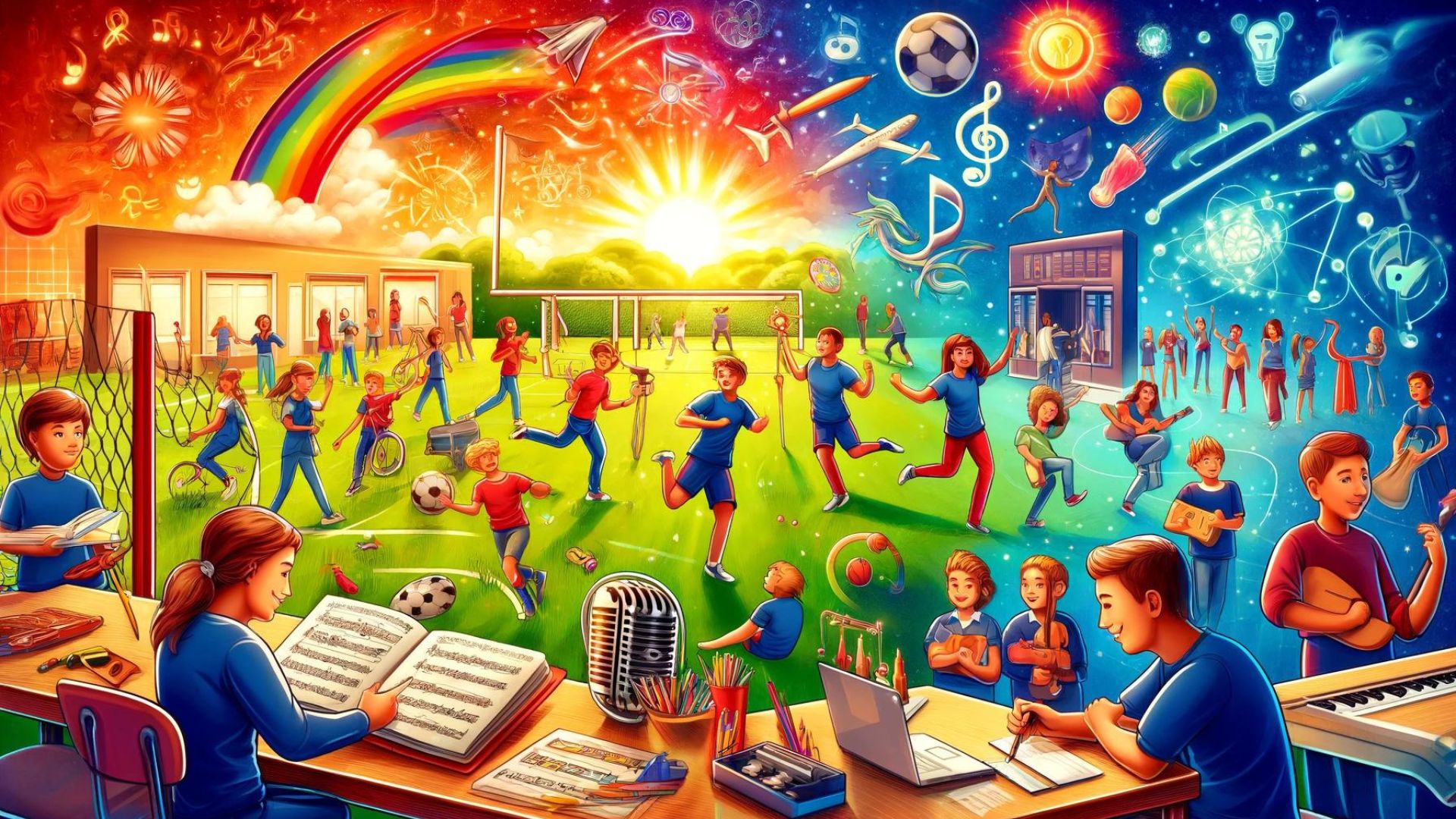Picture this: a quiet school hallway, suddenly bursting with the sounds of laughter, debate, music, and cheering. Classrooms once filled only with textbooks now buzz with robotics teams, student newspapers, mock trials, and art installations. This isn’t a scene from a movie – it’s the reality for schools that have harnessed the transformative power of extracurricular activities.
Why Extracurriculars Matter: More Than Just Fun and Games
Sure, extracurriculars are fun. But they’re so much more than that. They’re the secret sauce that can turn a good school into a great one, a place where students thrive academically, socially, and emotionally.
Here’s the magic they bring:
- Engagement: They ignite passions and spark curiosity, making school feel relevant and exciting.
- Skills for Life: Teamwork, leadership, communication, problem-solving – these are the 21st-century skills that extracurriculars nurture.
- Sense of Belonging: Clubs and teams create a community, a place where students feel connected and valued.
- Academic Boost: Studies show that students involved in extracurriculars often perform better in class, have higher attendance rates, and are more likely to graduate.
Real-Life Transformations: Stories from the Field
- The Robotics Revolution: In a low-income school district, a robotics club ignited a STEM revolution. Students who once struggled academically found purpose and confidence as they built and programmed robots. Their newfound passion translated into improved grades and a love for learning.
- The Debate Team Triumph: A small rural school with limited resources launched a debate team. Students learned to research, think critically, and articulate their ideas. They traveled to competitions, building self-esteem and expanding their horizons. The school’s reputation soared, attracting more students and resources.
- The Arts Explosion: An urban school with a high dropout rate invested in arts education. Dance, music, and theater programs provided an outlet for creativity and self-expression. Students found their voices, developed discipline, and formed lasting bonds. Attendance improved, and graduation rates climbed.
How Can You Make It Happen?
These are just a few examples of the incredible impact extracurriculars can have. The key is to find activities that resonate with your students and your community.
Here are some tips:
- Start small: Begin with a few clubs or teams and see what sparks interest.
- Empower students: Let them take ownership of the activities and make decisions.
- Partner with the community: Local businesses, organizations, and universities can offer resources and expertise.
- Celebrate successes: Recognize student achievements and showcase their talents.
Your Turn: Ignite the Spark
If you’re an educator, parent, or community member, you have the power to make a difference. Advocate for extracurricular activities in your school or community. Volunteer your time and talents. Support student-led initiatives.
Remember, extracurriculars aren’t just a bonus – they’re an essential part of a well-rounded education. By investing in them, we invest in the future of our students and our communities.
Why Should You Care?
Learning about the impact of extracurricular activities is crucial for anyone invested in education and the future of young people:
- Parents: Understanding the benefits of extracurriculars can help you guide your children toward activities that will enrich their lives and prepare them for success.
- Educators: This knowledge can inspire you to create and support extracurricular programs that foster student engagement, skill development, and well-being.
- Community Members: By understanding the positive impact of extracurriculars, you can advocate for resources and support for these programs in your community.
- Students: Exploring various extracurricular activities can help you discover hidden talents, passions, and potential career paths.
Key Takeaways
- Holistic Development: Extracurricular activities contribute to the overall development of students, nurturing academic, social, and emotional skills.
- Increased Engagement: These activities make learning more fun and relevant, boosting student motivation and participation.
- 21st-Century Skills: Extracurriculars foster critical thinking, problem-solving, teamwork, communication, and leadership abilities – skills essential for success in today’s world.
- Community Building: Clubs and teams create a sense of belonging and connection among students.
- Academic Success: Students involved in extracurriculars often experience improved academic performance and higher graduation rates.
Keywords & Definitions
- Extracurricular Activities: Activities that take place outside of regular academic classes, such as clubs, sports, and arts programs.
- Student Engagement: The level of attention, curiosity, interest, optimism, and passion that students show when they are learning or being taught.
- School Programs: Organized activities offered by a school to enhance student learning and development.
- Educational Initiatives: New or revised programs and practices designed to improve educational outcomes.
- Academic Performance: A student’s success in coursework, measured by grades, test scores, and other assessments.
- Social-Emotional Learning (SEL): The process of developing self-awareness, self-regulation, social awareness, relationship skills, and responsible decision-making.
- 21st-Century Skills: Core competencies such as critical thinking, creativity, collaboration, communication, and digital literacy.
- Community Engagement: The process of working collaboratively with individuals and groups to achieve common goals.
- Positive School Climate: A school environment characterized by safety, support, respect, and high expectations for all students.
- Holistic Education: An approach to education that focuses on the development of the whole person, not just academic skills.
Frequently Asked Questions (FAQs)
- Are extracurricular activities only for high school students? No, extracurricular activities are beneficial for students of all ages, from elementary school to college.
- How can schools with limited resources offer extracurricular programs? Schools can partner with community organizations, businesses, and universities to secure funding and resources. They can also leverage volunteers and student-led initiatives.
- Can extracurricular activities be too much for some students? Yes, it’s important for students to find a balance between academics and extracurriculars. Overcommitting to too many activities can lead to burnout and stress.
- Are there any negative effects of extracurricular activities? While rare, some students might experience negative social dynamics within extracurricular groups or feel pressure to participate in activities they don’t enjoy. Open communication and a supportive environment can help mitigate these issues.
Myth Buster
- Myth: Extracurricular activities are a distraction from academics.
- Reality: Research shows that students involved in extracurriculars often perform better academically, as these activities can enhance skills like time management, organization, and self-discipline.
- Myth: Only athletes and performers benefit from extracurriculars.
- Reality: There are a wide variety of extracurricular activities to cater to diverse interests, including academic clubs, service organizations, cultural groups, and more. Every student can find an activity that sparks their passion and helps them grow.
Let’s Talk!
- What role did extracurricular activities play in your own education or your child’s education?
- How can we ensure that all students have access to high-quality extracurricular programs?
- What are some innovative ways schools can incorporate extracurriculars into the curriculum?
Share your thoughts and experiences in the comments below! Let’s inspire each other to create thriving learning environments where every student can flourish.










0 Comments